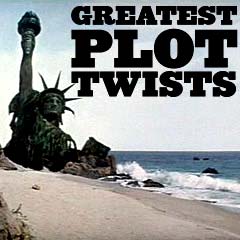
|
Film Spoilers and Surprise Endings D2 |
| |
||||||||
| Film Title/Year and Plot Twist-Spoiler-Surprise Ending Description | ||||||||

|
Deja Vu (2006)
Director Tony Scott's loud and noisy action thriller (with some paradoxical science-fiction elements) was an exciting murder mystery, although its implausible plot holes in the final, overly-confusing product were numerous. Its misleading trailers tauted the idea of deja vu, although the film had really nothing to do with the concept (the feeling as if you’ve been someplace or met someone, where you’ve never actually been before). Its main real-life antecedent was the Oklahoma City bombing. It centered on an investigation into a disaster that occurred on February 28, 2006 in New Orleans, LA (this was the first film shot in post-Katrina New Orleans) on the morning of Fat Tuesday. The Sen. Alvin T. Stumpf ferry carried hundreds of uniformed US Navy sailors and their families across the Mississippi River for Mardi Gras celebrations in the city. A ferry explosion at 10:50 am, presumably a deliberate domestic terrorist attack, resulted in 543 deaths of passengers and crew members. Assigned to the case was maverick ATF special agent Doug Carlin (Denzel Washington), adept at reading the details of bombed crime scenes. At the site of the disaster, he heard his own unique cellphone ring tone inside one of the black body bags.
Also mysteriously found in another body bag were the charred (30%) remains of 30 year old Claire Kuchever (Paula Patton) - it was determined that her body had washed up prior to the explosion.
Carlin speculated about bomb residue on the female victim: "The bomber came in direct contact with the victim. You solve her case, you solve this case." Did her murder have something to do with the ferry disaster, and could they track the killer through her during her last few days of life? A sophisticated, brand-new, futuristic system and multi-angle surveillance program (linked to seven orbiting satellites) labeled "Snow White," located at a top-secret government base, was used to relook at past events - it could even track through walls. Physicists explained that the privacy-busting device was limited to looking back only 4 days, 6 hours, 3 minutes, 45 seconds, and 14.5 nanoseconds. The investigators watched a satellite surveillance tape shot three days before Claire was taken from the Mississippi River - and Doug fell in love with the pretty image of the woman (a thematic plot similar to the one in Laura (1944)) after voyeuristically watching her every move, including seeing her step naked into a steamy shower. Although the physicists denied that she could detect the surveillance, Claire correctly sensed that she was being watched and wrote in her diary: "Got that weird I'm being watched feeling. It's like someone is out there..." In fact, the device allowed the physicists to view the actual past - to revisit and interact with it - revealed when Carlin shone a red laser-light into the past and Claire reacted to it (the scientists explained: "They found a way to fold space back onto itself...to create an instantaneous link between two distant points" - between the base and Claire's house, for example). The scientists also described how there were multiple planes of time, or different timelines branching out when one traveled back in time. If a new branch was created, what happened to the old one? "It might continue parallel to the new branch, but most likely, it ceases to exist."
During the early portion of the film, although it was unclear what was happening, Carlin was leaving clues from the past in the future (his fingerprints, bloody bandages, and the answering machine messages in Claire's place, the 'U Can Save Her' message on Claire's refrigerator, etc.) - maybe, as it has been speculated, during multiple trips back to the past. Doug sent a warning note back in time to himself - an "anonymous tip" to alert his 'past self' to the terror suspect's whereabouts (while surveilling the Algiers ferry dock at 4:40 am) in an attempt to prevent the bombing. The note on Carlin's desk was intercepted by Minuti, who approached the bomber at the dock and was eventually shot to death. They identified the terrorist as unrepentant and disturbed Carroll Oerstadt (Jim Caviezel), an embittered, unstable anti-social individual with a vendetta against the military after numerous enlistment rejections. He had contacted Claire about her '94 tan/red Ford Bronco SUV for sale, and ultimately kidnapped her in her home, duct-taped her mouth, murdered her (by setting her on fire with gasoline) in his own bait camp in the bayou, dumped her body in the river, and stole her SUV to use in the bombing. In the most preposterous sequence in the film, an absurd idea with a causal paradox, Carlin also went on an unauthorized time travel mission of his own to change the past. He returned back in time, as the 'future' Doug, to save his obsessive love interest Claire, stop Oerstadt and prevent the disaster ("It's time to prevent a crime before it happens"). Before his transport in the device (resembling a giant spark plug), technician Dr. Alexander Denny (Adam Goldberg) warned: "You don't have to do this." Carlin responded: "What if I already have?" [Note: It was likely that this wasn't his first mission back to the past.]
They drove away together in the happy ending, as the Beach Boys' "Don't Worry Baby" played on his radio |
 Ferry Explosion   Doug and Ferry Victim Claire (Paula Patton)  Claire Viewed in Shower  Doug's Reminder Note to Himself  Terrorist Carroll Oerstadt (Jim Caviezel)  "Snow White"  Oerstadt at the Bayou Bait Camp   Doug With Claire  Death of Oerstadt  Claire's SUV 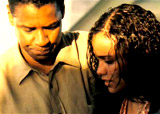 "Present Day" Doug United With Claire |
||||||

|
The Departed (2006)
Best Director-winning Martin Scorsese's viciously-violent Best Picture tale (an adaptation of Siu Fai Mak's Infernal Affairs (2002, HK)) was about reciprocally-planted 'moles' (or rats) within both the South Boston Irish-American mob and the Massachusetts State Police Department. The two moles (and a third) were:
It concluded with a bloody denouement in which almost all of the leading big-name cast members were killed (mostly by a single-gunblast to the head) - some abruptly and by complete surprise.
The film ended with a view of a real rat scurrying on the outdoor balcony railing of Sullivan's apartment against the backdrop of the gold-domed Massachusetts State House. One of the film's sub-plots was that police psychiatrist Madolyn Murray (Vera Farmiga) was dating both Costigan and Sullivan. She was living with Sullivan and secretly engaged to him. Costigan gave her an envelope - containing evidence of Sullivan's treachery. She survived, possibly carrying Sullivan's baby (or more likely, Costigan's baby). |
 Captain Queenan (Martin Sheen)  Frank Costello (Jack Nicholson)  Billy Costigan (Leonardo DiCaprio)  Colin Sullivan (Matt Damon)  Scurrying Rat |
||||||

|
Derailed (2005, UK/US)
Swedish director Mikael Håfstrom's suspenseful psychological drama-thriller (his first American feature film) was about the effects of a derailing adulterous affair (deceit, blackmail, etc.). The crime thriller was similar to the themes of classic noirs Double Indemnity (1944) and The Postman Always Rings Twice (1946), and more recently Fatal Attraction (1987) and Unfaithful (2002). The faux-noir began with a short under-the-credits sequence of an unidentified prisoner in his Illinois State Penitentiary cell beginning to write a story into a blue notebook: "The morning it all began, began like any other morning." Then, the film flashbacked to tell its fairly predictable tale - specifically it was a long set-up about how the man in the prison cell became involved with the film's main character:
At breakfast, Charles explained to his book-report-writing daughter that storytelling suspense was about the twisting plot seducing you to read further in ways you weren't expecting - it was a clear and predictable hint about what to expect in the way of a plot twist.
On a commuter train, Charles first viewed a femme fatale's legs in shiny spiked high heels (with black stockings). He was attracted to the intriguing, flirty, smart and attractive brunette Lucinda Harris (Jennifer Aniston) who paid his fare when he found himself broke (his wife had borrowed money from his billfold). She introduced herself as an employee at Avery Price: "I'm a financial advisor. I cheat clients" - a major tip-off to her character. During their next meeting, she told him she was married, and also whispered at him: "Some people just don't know how to appreciate what they've got." Before long, his sex obsession with the woman led to their clandestine rain-soaked coupling in a $46 room at the seedy Lake Hotel, at three in the morning. She enticed: "I think I wanna f--k you" - and as they furtively got undressed to make love, Charles heard the cocking of a gun. A French-accented, menacing armed man with a devil's goatee named Philippe LaRoche (Vincent Cassel) forcefully intruded into their room, held a gun to Lucinda's head, chided Charles for cheating with the "fine piece of ass," broke Charles' nose with his gun butt and rendered him into unconsciousness as he sadistically and repeatedly raped (mostly off-screen) the fully-clothed Lucinda. [Later, Lucinda falsely claimed that she had become pregnant from the rape and had an abortion.] The next morning, the guilt-ridden adulterers mutually decided to not report the violent attack to the police, due to their surreptitious tryst. Soon after, the creepy villain LaRoche blackmailed Charles for $20,000 (which was paid from his daughter's medical savings account nest egg), and then six weeks later demanded another $100,000. Charles attempted to have office mail-room employee Winston Boyko (rap artist RZA), an ex-con, threaten LaRoche, in return for $10,000. (Charles embezzled the $10,000 from an aspirin account that he was working on, to pay Winston.) The effort failed when LaRoche shot and killed Winston in the back of the head, and took his pay-off money. The next day, Charles was forced to pay the $100,000 to LaRoche as he held Lucinda at gunpoint in her Chicago apartment. And then he was considered a suspect for Winston's murder and doggedly questioned by Detective Franklin Church (Giancarlo Esposito) from the Chicago Police Department. The film's obvious and laughable twists came next:
Another major twist occurred. Charles admitted: "I CHOSE this prison" and stabbed LaRoche to death in the abdomen with Winston's makeshift knife (shank) given to him earlier. To the authorities, however, Charles claimed that LaRoche had tried to kill him with a knife that he had manufactured in prison. Detective Church was incredulous that Charles had been able to defend himself against LaRoche who had killed Winston and three others ("You expect me to believe that you overpowered him?"). Charles replied: "I guess I got lucky." Church also threatened Charles: "You brought that shank in with you, it's pre-meditated murder. Law don't care who you kill," although the knowing detective then released Charles to return home, realizing that LaRoche deserved retribution for killing his good friend Winston. Everything was reconciled and restored to normal in the anti-climactic finale, as Amy ran to her morning school bus - after she had been successfully treated with anti-rejection medication. |
 Chaz Schine (Clive Owen)     Charles "Chaz" Seduced by Lucinda Harris (Jennifer Aniston)   Assault by Philippe LaRoche (Vincent Cassel) on Lucinda  Death of Winston Boyko (RZA)  Blackmailer LaRoche  A New Target: Sam Griffin (David Morrissey)  Shoot-Out  Prison Laundry Room Encounter With LaRoche  Detective Church (Giancarlo Esposito) |
||||||

|
The Descent (2005, UK)
Neil Marshall's claustrophobic horror thriller told about a group of six, extremely-athletic female spelunkers (six unknown actresses) including:
The group were trapped deep underground in the dark in an Appalachian cavern after a cave-in. They realized that they were in the wrong place - not Boreham Caverns but an unknown and unmapped section ("We're in the wrong f--kin' cave!"). Juno admitted to everyone: "It hasn't got a name. It's a new system. I wanted us all to discover it. No one's ever been down here before." The six were very concerned that there wouldn't be a way out of the chamber.
The first intimation of horror was a quick appearance of a hairless, pale creature in the distance drinking water. The horrors were revealed to be predatory, sharp-toothed, whitish, carnivorous humanoid underground beasts called "crawlers" in the thick darkness, who attacked them relentlessly in the maze-like, entrapping lair. Sarah explained:
Holly was the first to have her throat ripped out by one of the crawlers. Juno was viciously attacked, and after knifing the creature with her pick-axe, she quickly turned around fearing another creature behind her. Horrified, she realized that she had swung her pick-axe and accidentally speared Beth in the neck. Later, Beth begged to be mercy-killed by Sarah, and her head was bashed in with a large rock. After she had killed one of the younger creatures, the beast's mother (with visible breasts) attacked Sarah and together they fell into a bloody pool. To protect herself, Sarah reached for a jagged bone and stabbed the creature in the eye - killing it. Sam and Rebecca were the next two victims of the creatures - Sam had her throat ripped while attempting to climb across a rocky roof to safety, and Rebecca was cannibalized alive when her stomach was chomped. Sarah and Juno were left to battle four of the creatures and a second wave of attackers. They were successful, although there was a confrontation between the two (Sarah believed that Juno had purposely harmed Beth), and Juno was injured by Sarah's pick-axe. In the ending, the wounded Juno died (off-screen) when she was surrounded by the creatures, but Sarah survived after escaping and falling unconscious down a chute. When she awoke, she crawled up a long pile of skeletal bones into daylight, where she emerged from the ground, took a deep breath of air, and then ran hysterically through the woods to her vehicle and drove away. After she stopped by the side of the road to puke, Sarah turned and saw Juno (with a blood-streaked face) in the passenger seat - Sarah screamed - and then the trauma of the vision caused her to awaken underground, where she realized that her escape was only an hallucination. In one final vision, she imagined her tragically-killed daughter Jessica's birthday (and a candle-covered birthday cake) as she stared into her torch's flame (her daughter spoke: "Mummy?"), and the camera drew backward into the darkness as her flame began to dim. She had imagined that the flickering flames of her torch were the candles on the cake. The sounds of creatures threatening to attack were heard. The credits played atop a black and white group photo of the six cave-explorers. [In the North American release, the film ended a minute earlier, at the point where Sarah saw Juno. The UK version was considered too dark for American audiences and was modified.] |
    Sarah's Escape to Daylight and a Vehicle?  Vision of Juno in Car  Only an Hallucination  Her Daughter Jessica's Birthday Cake  B/W Photo of Six Spelunkers |
||||||
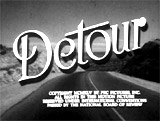
|
Detour (1945)
In this gritty Edgar Ulmer B-film noir told in flashback, fatalistic, self-pitying, down-and-out Al Roberts (Tom Neal) was seated in a tawdry Reno diner where he told about recent events and imagined his pending arrest. Roberts had found himself as a hitchhiker in the car of businessman Charles Haskell, Jr. (Edmund MacDonald) on the way to LA - when Haskell died from a heart attack. When Roberts feared he would be arrested for murder, he dumped Haskell along the side of the Arizona road and stole his identity (wallet, clothes, and car). In California, he picked up vulturous and despicable femme fatale hitchhiker Vera (Ann Savage), who suspected that he had deliberately 'killed' Haskell ("You're a cheap crook and you killed him"), so she blackmailed him for money. During a vicious argument one night in a San Bernardino hotel when Vera threatened to call the Hollywood police station, he accidentally killed the castrating, drunken and exploitative Vera. After she had called him a "yellow stinker" and accused him of not being a "gentleman," she ordered him to open up the windows. It was a ploy - she grabbed the phone and raced into the adjoining room where she locked herself in. He pulled on the long phone cord extension through the closed door, which she had inexplicably wrapped around her neck. When she ignored his promise to do anything she asked for, he began yanking on the cord and pulled it as tightly as possibly (with a close-up of his straining fists). Then, he broke down the door and saw her body lying on the bed - reflected in a mirror. This was a a second disastrous twist of fate! He knew his fate was sealed, as he spoke in voice-over:
The film ended with Roberts being picked up by a patrol car for the murder of Vera. |
 Al Roberts (Tom Neal) Explaining Fate in Flashback  Al and Hitchhiker Vera (Ann Savage) 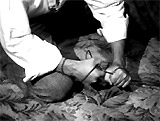  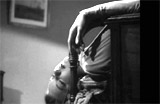 Vera's Accidental Telephone Cord Strangulation |
||||||

|
Devil (2010) (aka The Night Chronicles: Devil)
Director John Erick Dowdle's low-budget supernatural horror film was based upon a story by M. Night Shyamalan (scripted by Brian Nelson), the "master" of plot-twist films, although Shyamalan was often accused of cheap third-act twists. The edgy thriller was to be the first film in The Night Chronicles trilogy. Two of the film's taglines told a lot about the plot - that there would be no coincidences:
This theme was similar to many classic mystery tales (i.e., Agatha Christie's And Then There Were None, which was made into two different films with the same title in 1945 and 1974, and also as Ten Little Indians in 1965 and 1989, along with the comedy spoof Murder By Death (1976)), in which a group of people were trapped in an isolated or inescapable location, and one by one, they died off. [Note: Other films with the same premise: Hitchcock's Lifeboat (1944), Cube (2003), Open Water (2003), Buried (2010) and many others, kept a group of individuals in a confined, dangerous situation.] The plot twist often contained the same ingredient - the villain, thought to be dead, was one of the remaining survivors. The prologue's Biblical quote (inaccurately credited as Peter 5:8) set up the plot:
A gruesome and disturbing folktale ("old wives' tale") told at bedtime, titled "The Devil's Meeting," was described (in voice-over) in early sequences by a religiously fanatical, superstitious security guard Ramirez (Jacob Vargas). Its premise inspired the storyline: the Devil (El Diablo) was to take human form, hide amongst everyone, and torture and punish various damned individuals who had sinned. Other innocents would die along the way, trying to help out. The film opened with a striking, inverted helicopter shot of the city of Philadelphia's harbor and downtown, and then a suicide jump from a window on the 35th floor of a skyscraper ("paving the way for the Devil's arrival"). The end credits identified the five individuals who would soon become trapped in the same building's high-rise office elevator, stuck at the 21st floor during the suicide investigation. They were listed by their occupations or descriptions, not by their character names:
Called into the case was recovering alcoholic Detective Bowden (Chris Messina) with his loyal assistant Markowitz (Josh Peace). Bowden was still suffering from an incident five years earlier - the hit and run death of his own wife and toddler son, by someone who left the scene after writing an apology on the back of a car wash coupon. The two officers soon discovered that all five occupants had dark or criminal pasts in some way, were potentially capable of murder, or deserved to be killed. They had all done evil things, it seemed:
Therefore, according to Ramirez, it was Satan's plan:
The elevator occupants were doomed to experience vengeful punishment by Satan posing as a human. There were frequent power failures, hallucinations regarding what was happening (Ramirez saw a "face" superimposed on the elevator, and the Young Woman had a vision of everyone bloodily slaughtered). In addition, there were recriminations and shifting blame, and a rescue attempt by repair technician Dwight (Joe Cobden) in the shaft that ended with a fall to his death onto the top of the elevator. Another guard named Lustig (Matt Craven) was electrocuted. The elevator characters began dying one by one (each time when the lights went dark):
Mechanic Tony - the last survivor, repentently confessed to a revived and spiteful Jane (with pupils dilated revealing herself to be Satan), and via radio to Detective Bowden, that he was the drunk hit-and-run driver who had killed Bowden's family years earlier. On the way to the police station, Bowden reciprocated and forgave Tony for his sin. The film's moralizing final line was delivered by Ramirez (in voice-over): "If the Devil is real, then God must be real, too." |
   Stalled Elevator Crisis  Security Guard Ramirez (Jacob Vargas) and Detective Bowden (Chris Messina) Elevator Deaths:  Salesman Vince (Geoffrey Arend)  Old Woman Jane (Jenny O'Hara)  Guard Ben (Bokeem Woodbine)  Young Woman Sarah (Bojana Novakovic)  The Satan Figure  Mechanic Tony (Logan Marshall-Green) Confessing to Det. Bowden  Det. Bowden |
||||||

|
The Devil's Advocate (1997)
During a particularly difficult trial, young Florida defense attorney Kevin Lomax (Keanu Reeves) sold his soul (selling his soul to the devil was part of an elaborate daydream in which he fantasized that he was about to compromise his integrity by representing a guilty client in the case of a child-molester schoolteacher named Mr. Gettys (Chris Bauer)). He was about to acquit the child molester by discrediting the victim during cross-examination. In his fantastic daydream, he chose to go into the corrupted service of Satanic John Milton (Al Pacino) (deliberately named to imply his "Paradise Lost") at a law firm in New York. Lomax fantasized that his distressed wife Mary Ann (Charlize Theron) had been raped and then committed suicide, and that Milton was his father. Afterwards, when Mary Ann was incarcerated in a mental institution, she slit her throat as Kevin tried to break into her room to prevent her from hurting herself. Milton temptingly offered him his nude half-sister Christabella Andreoli (Connie Nielsen) for sex - to father the Anti-Christ - Lomax responded by committing suicide by shooting himself in the head, citing his use of 'free will.' In reaction, Milton cried "No!" and burst into raging flames (and was converted into his angelic form), while a naked Christabella was age-withered and died. After this climactic series of events, in the first of two major plot twists, Lomax was returned to the Gettys case courtroom during a recess period - where he then announced in the courtroom (as part of doing "the right thing") that he would no longer represent his guilty client - thus threatening his own disbarment. A press newsman named Larry (Neal Jones) who was covering the case summed up Lomax's decision as a future sensational media story:
After tempting the couple to agree to a news story, the newsman morphed into Milton as they left, gloating with a devilish grin:
He was insinuating that the Devil still had plans to intervene in the Lomax's lives. He was determined to try again. Milton dissolved into flames as The Rolling Stones' Paint It, Black played. |
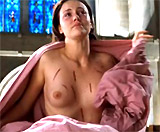 Mary Ann (Charlize Theron) Nude in Church  Mary's Ann's Suicide   Suicide of Attorney Kevin Lomax (Keanu Reeves)   Reaction of Satanic John Milton (Al Pacino)   Christabella Andreoli (Connie Nielsen) Withering |
||||||

|
Les Diaboliques (1955, Fr.) (aka Diabolique)
French director Henri-Georges Clouzot's psychological horror-thriller was one of the earliest films to feature a shocking plot twist in its conclusion. It was adapted for the screen from Pierre Boileau's and Thomas Narceja's 1951 novel Celle Qui N'était Plus (She Who Was No More). This film was one of the first to actually contain an end-credits 'anti-spoilers' director's statement that advised viewers to keep the film's ending a secret:
The main characters were:
In the story, the two females plotted to drug Michel and drown him in a bathtub in Nicole's country house (closeby to the school, in an isolated village), and then dump his body in the school's swimming pool. But then Michel's body went missing from the pool, and there were several possible sightings - was he still alive? In the film's famous shocking twist ending after following a curving plotline, Michel was never killed by them. He had faked his own death - with collaborative help by Nicole - so Christina could be murdered. When Christina unexpectedly saw Michel's corpse in the bathtub, it caused her (and the audience) to have a fright-induced heart attack, when he rose zombie-like out of a bathtub with half-opened, all-white eyes. She clutched her chest in the vicinity of her heart, fell back against the wall and slid to the floor where she collapsed.
After she slumped over dead, he popped the fake eye lenses from his eyes, exited the tub, and checked Christina's arm for a pulse. After unlocking the apartment door, Nicole rushed into his arms for embraces and kisses. Their plan was to become rich by selling the "fire-trap" school that he would inherit from his deceased wife. However, the two conspirators were immediately arrested by retired private detective Alfred Fichet (Charles Vanel), who predicted that they would be imprisoned for 15-20 years. In the film's resolution the next day as the school was closing, there was another possible twist regarding the fate of Christina. Confused, truth-telling or lying (?) schoolboy Moinet (Yves-Marie Maurin) declared that Christina had just given him back his confiscated slingshot (which he used to break a window) that morning - the film's last line as he walked away:
|
   Heart Attack of Christina  Schoolboy Moinet (Yves-Marie Maurin) with Slingshot  Director's Statement |
||||||
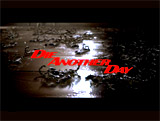
|
In this 20th James Bond film (the fourth with Pierce Brosnan), there were two major identity shifts. The 007 agent was first up against a very crafty, rogue North Korean weapons dealer named Colonel Tan-Sun Moon (Will Yun Lee). He was Harvard educated and cynically bragged about his corruption by Western education ("majored in Western hypocrisy"). After it appeared in the opening sequence that Moon had been killed when his hovercraft plunged off a steep cliff into a waterfall, he later resurfaced in the film as an entirely different character, after having his appearance entirely altered (and his accent too). He secretly underwent painful DNA replacement gene therapy at a "strange" treatment center-clinic on Isla de Los Organos, an offshore facility (later called a "beauty parlor") near Havana, Cuba run by Dr. Alvarez (Simon Andreu). Even his father General Moon (Kenneth Tsang) was unaware of his son's survival and drastic transformation.
Moon's new character was introduced as:
It was a good-will cover for laundering African conflict diamonds, and for carving an invasion path from North Korea into South Korea, by destroying the minefield in the DMZ between the two countries - "creating a highway for our troops" and opening S. Korea up to invasion. His publicist was mysterious blonde Miranda Frost (Rosamund Pike), a fencing expert - and as it turned out in another minor plot twist, M's (Judi Dench) newest undercover MI6 agent. She had been on the Graves case for three months after volunteering, and claimed: "Graves seems to be clean" although Bond believed differently. It was at first a surprise when she revealed to Bond that she was a fellow agent, and let herself be seduced by him. Then, when she appeared to be on Bond's side and held a gun on Graves, the villain noted: "Miss Frost is not all she seems" and Bond added: "Looks can be deceptive" - but then she swiveled her gun to face it toward Bond, and was about to follow orders to kill Bond. She was the traitorous double-agent MI6 mole who had betrayed Bond's identity in Korea in the film's opening (and it was revealed that she had met the Korean General at Harvard when they were students there together). Graves smirked:
When Bond attempted to fire his gun, Miranda told how she had sabotaged it when they slept together. Graves explained how he fatally poisoned Frost's opponent in the Olympics fencing competition in order to win her loyalty:
Bond critiqued: "The coldest weapon of all." |
    Traitorous Double Agent Miranda Frost (Rosamund Pike) with Graves |
||||||